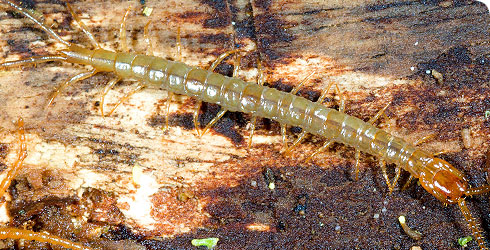Biology
The centipede grows up to 37mm long, excluding antennae and legs.
All known specimens of this species have the adult number of 15 trunk leg pairs, but early post-embryonic stages have not yet been discovered.
The closely related Australian Craterostigmus tasmanianus has an early juvenile stage with 12 leg pairs but attains the 15-segmented condition early in post-embryonic development.
Life cycle
Few details are available on C. crabilli’s reproduction.
The Tasmanian relative C. tasmanianus has maternal care - the mother inhabits a hollow in moist, rotting wood and ceases to feed while wrapping her body around a clutch of 44–77 eggs. Brooding has been observed between September and April (Mesibov, 1995).
The sex of most specimens cannot be determined externally because the genital segments are usually retracted into the ring of segment 15. When these segments are extruded, females have a median suture on the first genital sternite, males have a small gonopod.
Although the life expectancy of C. crabilli is unknown, similarly sized species of other centipede orders - Lithobiomorpha and Scolopendromorpha - live for several years in captivity.
Toolbox
Glossary
Coxosternite
Plate at the base of the maxillipedes, composed of the fused coxa (the basal leg segment) and sternum.
Epimorphic
Same number of body segments at different stages of lifecycle.
Gonopod
A modified pair of legs that functions as an external reproductive organ.
Labrum
Lip that originates at the border of the mouth in arthropod development.
Malpighian tubules
Tubes used for excretion.
Maxillary telopodite
The outer, segmented part of the first pair of mouth appendages immediately behind the mandibles (jaws).
Maxillipede
Modified anterior pair of trunk legs that are a functional part of the head.
Ocellus
Eye structure.
Sclerites
Hardened plate like body parts.
Sternite
Plates on ventral surface.
Tergites
Plates along the back.
Trochanter
Second segment of a leg, between the coxa and the prefemur.
